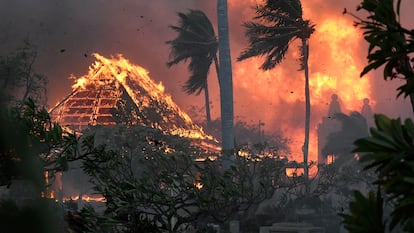What’s driving Maui’s devastating fires, and how climate change is fueling those conditions
Experts say climate change is increasing the likelihood of more extreme weather events like what’s playing out in Hawaii, where dozens of people have been killed and a historic tourist town was devastated

A dangerous mix of conditions appears to have combined to make the wildfires blazing a path of destruction in Hawaii particularly damaging, including high winds, low humidity and dry vegetation. Experts also say climate change is increasing the likelihood of more extreme weather events like what’s playing out on the island of Maui, where dozens of people have been killed and a historic tourist town was devastated.
“It’s leading to these unpredictable or unforeseen combinations that we’re seeing right now and that are fueling this extreme fire weather,” said Kelsey Copes-Gerbitz, a postdoctoral researcher at the University of British Columbia’s faculty of forestry. “What these ... catastrophic wildfire disasters are revealing is that nowhere is immune to the issue.”
Here’s a look at the Maui fires, and what’s behind them:
What’s fueling them?
Major differences in air pressure drove unusually strong trade winds that fanned the destructive flames, according to meteorologists.
Trade winds are a normal feature of Hawaii’s climate. They’re caused when air moves from the high-pressure system pressure north of Hawaii — known as the North Pacific High — to the area of low pressure at the equator, to the south of the state.
But Hurricane Dora, which passed south of the islands this week, is exacerbating the low-pressure system and increasing the difference in air pressure to create “unusually strong trade winds,” said Genki Kino, a meteorologist with the National Weather Service office in Honolulu.
Hawaii’s state climatologist, Pao-Shin Chu, said he was caught off guard by the impact Dora had from roughly 500 miles (800 kilometers) away.
“Hurricane Dora is very far away from Hawaii, but you still have this fire occurrence here. So this is something we didn’t expect to see,” he said.
Strong winds, combined with low humidity and an abundance of dry vegetation that burns easily, can increase the danger of wildfire, even on a tropical island like Maui.
“If you have all of those conditions at the same time, it’s often what the National Weather Service calls ‘red flag conditions,’” said Erica Fleishman, director of the Oregon Climate Change Research Institute at Oregon State University.
How climate change plays a role
“Climate change in many parts of the world is increasing vegetation dryness, in large part because temperatures are hotter,” Fleishman said. “Even if you have the same amount of precipitation, if you have higher temperatures, things dry out faster.”
Clay Trauernicht, a fire scientist at the University of Hawaii, said the wet season can spur plants like Guinea grass, a nonnative, invasive species found across parts of Maui, to grow as quickly as 6 inches (15 centimeters) a day and reach up to 10 feet (3 meters) tall. When it dries out, it creates a tinderbox that’s ripe for wildfire.
“These grasslands accumulate fuels very rapidly,” Trauernicht said. “In hotter conditions and drier conditions, with variable rainfall, it’s only going to exacerbate the problem.”
Stronger hurricanes
Climate change not only increases the fire risk by driving up temperatures, but also makes stronger hurricanes more likely. In turn, those storms could fuel stronger wind events like the one behind the Maui fires.
That’s on top of other threats made worse by climate changes.
“There’s an increasing trend in the intensity of hurricanes worldwide, in part because warm air holds more water,” Fleishman said. “In addition to that, sea levels are rising worldwide, so you tend to get more severe flooding from the storm surge when a hurricane makes landfall.”
While climate change can’t be said to directly cause singular events, experts say, the impact extreme weather is having on communities is undeniable.
“These kinds of climate change-related disasters are really beyond the scope of things that we’re used to dealing with,” UBC’s Copes-Gerbitz said. “It’s these kind of multiple, interactive challenges that really lead to a disaster.”
Sign up for our weekly newsletter to get more English-language news coverage from EL PAÍS USA Edition
Tu suscripción se está usando en otro dispositivo
¿Quieres añadir otro usuario a tu suscripción?
Si continúas leyendo en este dispositivo, no se podrá leer en el otro.
FlechaTu suscripción se está usando en otro dispositivo y solo puedes acceder a EL PAÍS desde un dispositivo a la vez.
Si quieres compartir tu cuenta, cambia tu suscripción a la modalidad Premium, así podrás añadir otro usuario. Cada uno accederá con su propia cuenta de email, lo que os permitirá personalizar vuestra experiencia en EL PAÍS.
¿Tienes una suscripción de empresa? Accede aquí para contratar más cuentas.
En el caso de no saber quién está usando tu cuenta, te recomendamos cambiar tu contraseña aquí.
Si decides continuar compartiendo tu cuenta, este mensaje se mostrará en tu dispositivo y en el de la otra persona que está usando tu cuenta de forma indefinida, afectando a tu experiencia de lectura. Puedes consultar aquí los términos y condiciones de la suscripción digital.
More information
Archived In
Últimas noticias
Raúl Rocha, from jet-setting with Miss Universe to arms trafficking and fuel theft
80,000 barrels of Mexican oil sent to Cuba: Havana drawn into the US–Mexico clash
Human rights activists, opposition members, and a minor: Maduro’s other political prisoners
Israel sparks a civil war within the MAGA movement
Most viewed
- Reinhard Genzel, Nobel laureate in physics: ‘One-minute videos will never give you the truth’
- Pablo Escobar’s hippos: A serious environmental problem, 40 years on
- Charles Dubouloz, mountaineering star, retires at 36 with a farewell tour inspired by Walter Bonatti
- Why we lost the habit of sleeping in two segments and how that changed our sense of time
- The Florida Keys tourist paradise is besieged by immigration agents: ‘We’ve never seen anything like this’










































